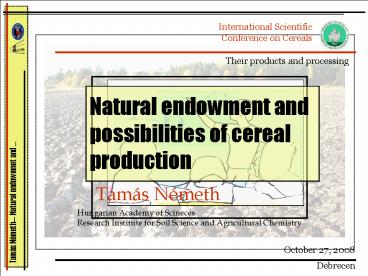PowerPoint bemutat - PowerPoint PPT Presentation
1 / 28
Title:
PowerPoint bemutat
Description:
Their products and processing. Natural endowment and possibilities of cereal ... 15: Portugal; 16: United Arab Emirates; 17: Spain; 18: Ireland; 19: Finland; ... – PowerPoint PPT presentation
Number of Views:30
Avg rating:3.0/5.0
Title: PowerPoint bemutat
1
International Scientific Conference on Cereals
Their products and processing
Natural endowment and possibilities of cereal
production
Tamás Németh Natural endowmnet and
Tamás Németh
Hungarian Academy of Scineces Research Institute
for Soil Science and Agricultural Chemistry
October 27, 2008
Debrecen
2
Tamás Németh Natural endowmnet and
3
Characteristics of Hungary
A landlocked, Central European country in the
Carpathian Basin Area 93,030 km2 Population
10,139,000 Besides this, 2.0 million Hungarians
live in Romania, 0.6 million in Slovakia,
0.45-0.45 million in Serbia, and in the USA,
0.17 million in Ukraine, and many in other
countries. 1/3 of all Hungarians live outside
Hungary Peoples Magyar (Hungarian) 88.8
Gypsy 3.8 Ruthen 2.8 German 1.7 Jews
0.8 Romanian 0.4 Slovakian 0.3 Polish,
Croatian, Serb 0.2-0.2. Per capita GDP 7.831
USD / 11.750 USD Proportion of agriculture and
food industry from GDP 7-10
Tamás Németh Natural endowmnet and
4
Average annual precipitation in Hungary
Tamás Németh Natural endowmnet and
5
Annual mean temperature in Hungary
Tamás Németh Natural endowmnet and
6
Land use pattern categories in Hungary,
1901-2000
Tamás Németh Natural endowmnet and
7
Soil type of Hungary
Tamás Németh Natural endowmnet and
8
Soil reaction and carbonate status in Hungary
Tamás Németh Natural endowmnet and
9
Soil texture of Hungary
Tamás Németh Natural endowmnet and
10
Yield increases in main producer countries,
1950-1987
Tamás Németh Natural endowmnet and
11
Correlation between per capita GDP and the
magnitude of P fertilizer application, as grouped
by the population density, in the year of 2000.
(Csathó, 2003)
Tamás Németh Natural endowmnet and
Other countries 1 Bangladesh 2 Pakistan 3
India 4 China 5 Croatia 6 Turkey 7
Thailand 8 Brazil 9 Costa Rica 10 Poland
11 Hungary 12 Czech Republic 13 Chile 14
Greece 15 Portugal 16 United Arab Emirates
17 Spain 18 Ireland 19 Finland 20
Netherlands 21 France 22 Belgium-Luxemburg
23 Germany 24 Sweden 25 United Kingdom 26
Austria 27 Denmark 28 Canada.
12
World NPK fertilizer consumption, million
tonnes of N-P2O5-K2O, 1950-2000 (FAO Fertilizer
Yearbooks)
Tamás Németh Natural endowmnet and
13
Fertilizer consumption in Hungary, 1901-2000
Tamás Németh Natural endowmnet and
14
Total production of main crops in Hungary,
1901-2000
Tamás Németh Natural endowmnet and
15
Volume of livestock production in Hungary,
1901-2000
Tamás Németh Natural endowmnet and
16
NPK balances in Hungary, 1901-2000 (Agronomic
approach, Csathó and Radimszky, 2000)
Tamás Németh Natural endowmnet and
17
Cummulative NPK balances in Hungary,
1901-2000 (Agronomic approach, Csathó and
Radimszky, 2003)
Tamás Németh Natural endowmnet and
18
Comparison of the philosophies of intensive (MÉM
NAK) and sustainable, environmentally friendly
(RISSAC-RIA) fertiliser recommendation systems,
resp. (Based on the data set of the Hungarian
long-term field trials, 1960-2000)
Tamás Németh Natural endowmnet and
19
Formula of the new, environmentally friendly
fertilizer recommendation system
F (Ye x Sy x M) C, where F recommended
N-, P2O5 and K2O kg/ha doses, Ye the expected
yield level, Sy specific nutrient contents,
expressing the nutrient quantities ?kg?, found in
one tonne of yield, depending on the expected
yield level, M multiplication factor,
depending on the soil nutrient supply categories,
C fertiliser dose correcting factors (type of
pre-crop, aboveground plant residues remaining on
the field, previous farmyard manure application,
etc.).
Tamás Németh Natural endowmnet and
20
T. Lewis (1994)
They should stand not only as a landmark of
progress, but as pointers to new studies
neccessary to sustain and improve productive
agriculture worldwide in an attractive
environment.
Tamás Németh Natural endowmnet and
21
Setting or revision of long-term experiment
- experiment methodology question
- posing scientific question
- treatments and planning
- regional homogeneity
- multifunctional
Tamás Németh Natural endowmnet and
22
Sustainability of long-term experiments
- homogeneous area
- elimination of carrying over
- protection for degradation processes
Tamás Németh Natural endowmnet and
23
Possibilities of long-term experiments
1. Choosing the location of adjustment (for
long time) 2. Ensure the sustainability
(minimum requirement system) 3. Necessary
changes
Tamás Németh Natural endowmnet and
- treatments
- cultivation
- harvest
- changing without damage of long-term
- answering for the occurent new questions
24
New aspects for approaches
- Opportunities for posing new questions and new
generations latching on to are one of the most
important characteristic of the long-term
experiments - The long-term experiments are adapted to follow
the environmental changes, analyse the changes
which can take effect on experiments monitoring - Possibility for estimate the impacts of the short
and long time changes
Tamás Németh Natural endowmnet and
25
Sustainable development
Climate change
Long-term experiments
Tamás Németh Natural endowmnet and
Environment protection
Industrial and urban load
26
Possibilities
- Follow the environmental changes
- Monitoring
- Development, testing and calibrate of new methods
and techniques - Start new type of searches
- Call in new type of estimation
- (statistic and modelling)
Tamás Németh Natural endowmnet and
statistic methods
data collecting
27
The main characteristic of the long-term
experiments is that it is based on a supposition,
which can be changed in the course of time, it
seeks answers of new challenges, broadens the
scale of the measured parameters, looks for
answers, than asks again.
Tamás Németh Natural endowmnet and
28
Thank you for your attention!
Tamás Németh Natural endowmnet and































